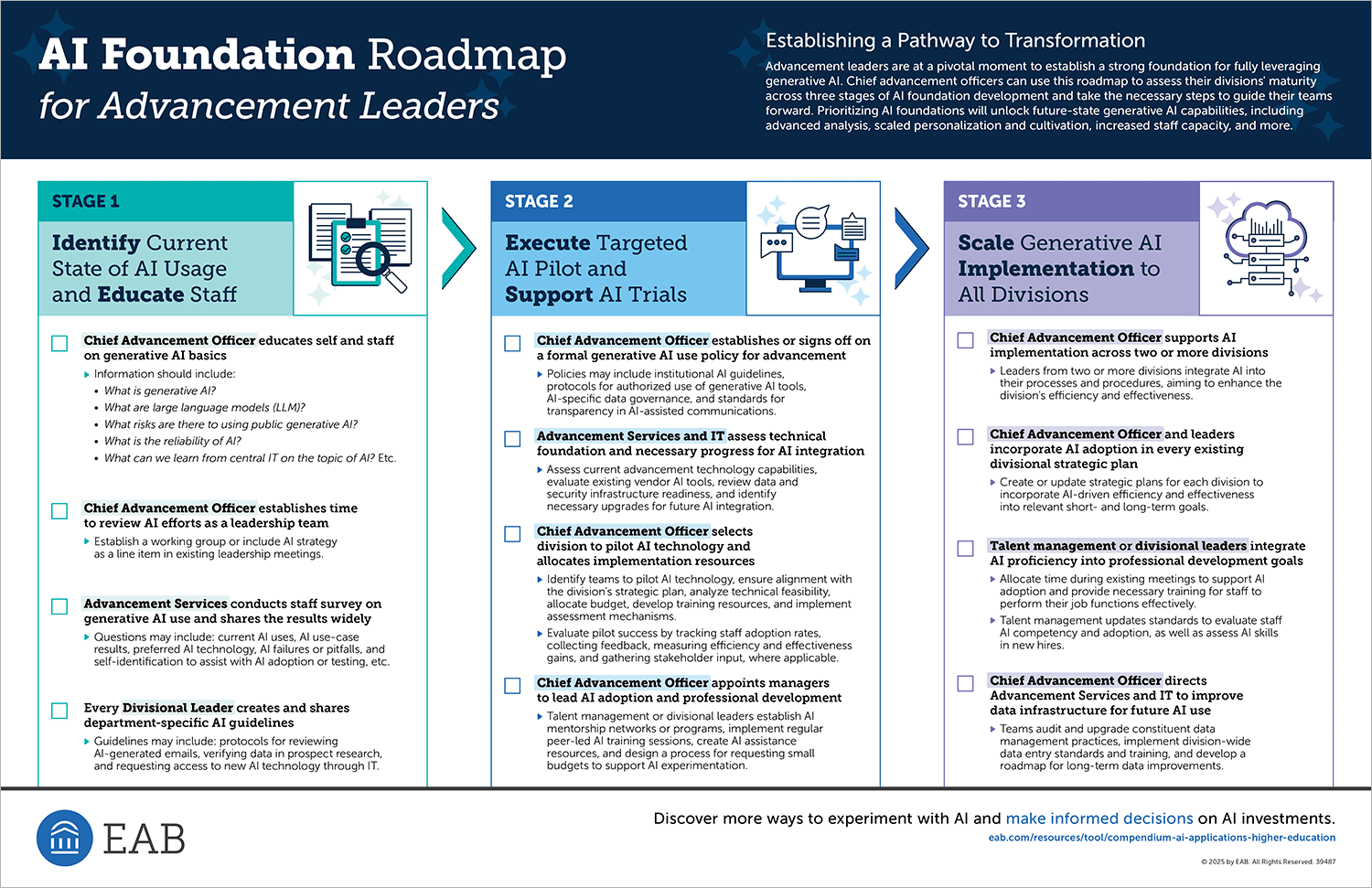Infographic
AI foundation roadmap for advancement leaders
Establishing a pathway to transformation
Advancement leaders are at a pivotal moment in establishing a strong foundation for fully leveraging generative AI. Chief advancement officers can use this roadmap to assess their divisions’ maturity across three stages of AI foundation development and take the necessary steps to guide their teams forward. Prioritizing AI foundations will unlock future-state generative AI capabilities, including advanced analysis, scaled personalization and cultivation, increased staff capacity, and more.
Three stages of AI foundation development
Stage 1: Identify current state of AI usage and educate staff
- Chief advancement officer educates self and staff on generative AI basics
- Information should include:
- What is generative AI?
- What are large language models (LLM)?
- What risks are there to using public generative AI?
- What is the reliability of AI?
- What can we learn from central IT on the topic of AI?
- Information should include:
- Chief advancement officer establishes time to review AI efforts as a leadership team
- Establish a working group or include AI strategy as a line item in existing leadership meetings
- Advancement services conducts staff survey on generative AI use and shares the results widely
- Questions may include: current AI uses, AI use-case results, preferred AI technology, AI failures or pitfalls, self-identification to assist with AI adoption or testing, etc.
- Every divisional leader creates and shares department-specific AI guidelines
- Guidelines may include: protocols for reviewing AI-generated emails, verifying data in prospect research, and requesting access to new AI technology through IT
Stage 2: Execute targeted AI pilot and support AI trials
- Chief advancement officer establishes or signs off on a formal generative AI use policy for advancement
- Policies may include institutional AI guidelines, protocols for authorized use of generative AI tools, AI-specific data governance, and standards for transparency in AI-assisted communications
- Advancement services and IT assess technical foundation and necessary progress for AI integration
- Assess current advancement technology capabilities, evaluate existing vendor AI tools, review data and security infrastructure readiness, and identify necessary upgrades for future AI integration
- Chief advancement officer selects division to pilot AI technology and allocates implementation resources
- Identify teams to pilot AI technology, ensure alignment with the division’s strategic plan, analyze technical feasibility, allocate budget, develop training resources, and implement assessment mechanisms
- Evaluate pilot success by tracking staff adoption rates, collecting feedback, measuring efficiency and effectiveness gains, and gathering stakeholder input, where applicable
- Chief advancement officer appoints managers to lead AI adoption and professional development
- Talent management or divisional leaders establish AI mentorship networks or programs, implement regular peer-led AI training sessions, create AI assistance resources, and design a process for requesting small budgets to support AI experimentation
Stage 3: Scale generative AI implementation to all divisions
- Chief advancement officer supports AI implementation across two or more divisions
- Leaders from two or more divisions integrate AI into their processes and procedures, aiming to enhance the division’s efficiency and effectiveness
- Chief advancement officer and leaders incorporate AI adoption in every existing divisional strategic plan
- Create or update strategic plans for each division to incorporate AI-driven efficiency and effectiveness into relevant short- and long-term goals
- Talent management or divisional leaders integrate AI proficiency into professional development goals
- Allocate time during existing meetings to support AI adoption and provide necessary training for staff to perform their job functions effectively
- Talent management updates standards to evaluate staff AI competency and adoption, as well as assess AI skills in new hires
- Chief advancement officer directs advancement services and IT to improve data infrastructure for future AI use
- Teams audit and upgrade constituent data management practices, implement division-wide data entry standards and training, and develop a roadmap for long-term data improvements
More Resources

Infographic
Annual giving’s critical role in the journey to major gifts
This infographic illustrates how annual giving supports every stage of the donor journey, from first gift to leadership…
Advancement Marketing Services

Tool
Advancement Diagnostic
This Advancement Diagnostic offers a quick, practical way to assess whether your strategy is positioned to deliver results…
Advancement Marketing Services

Tool
Planning During Times of Uncertainty
This planning tool helps advancement leaders stress-test their strategy against uncertainty.
Advancement Marketing Services
